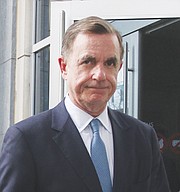No go
5 City Council members ask Mayor Stoney to withdraw $1.5B Coliseum replacement and Downtown redevelopment plan, a major signal he doesn't have the votes needed for approval
Jeremy M. Lazarus | 1/31/2020, 6 a.m.
The $1.5 billion Coliseum replacement plan is dead.
Five members of Richmond City Council sounded the death knell Monday night by introducing a resolution calling on Mayor Levar M. Stoney to withdraw the ordinances regarding the project he presented last summer and to work with City Council to create a plan for developing the city-owned property near City Hall that could generate public support.
The rebuff echoes the council’s show of opposition that doomed Mayor Dwight C. Jones’ plan to build a baseball stadium in Shockoe Bottom and led him to withdraw the proposal in May 2014 ahead of the vote.
And it also confirms that the project does not have the seven votes needed to win approval from the nine-member council.
Council members signing the resolution that will be considered Monday, Feb. 3, are Kim B. Gray, 2nd District; Chris A. Hilbert, 3rd District; Kristen N. Larson, 4th District; Stephanie A. Lynch, 5th District; and Reva M. Trammell, 8th District.
Mayor Stoney quickly rejected any notion of withdrawing the plan and accused the five council members of trying to avoid publicly voting against the Navy Hill plan during an election year.
The Navy Hill District Corp., led by Thomas F. “Tom” Farrell II, Dominion Energy’s top executive, designed the plan being pushed by Mayor Stoney. It calls for replacing the vacant Richmond Coliseum with a new, larger 17,500-seat arena, creating thousands of new jobs and huge benefits for selected black contractors. The development also would have a large convention hotel, new office buildings, more than 2,000 new apartments and condos and new retail shops and restaurants. All would go on eight blocks north of Marshall Street near City Hall and two blocks south of Broad Street.
If Mayor Stoney goes forward and insists on a council vote on the plan on Monday, Feb. 24, the certainty of defeat was made clear by Mr. Hilbert, the City Council vice president, following the resolution’s introduction at the end of the council meeting on Monday night.
“I told the mayor several months ago that I was a hard no,” said Mr. Hilbert, who reviews real estate projects as a senior underwriter for the Virginia Housing Development Authority. “There is no air and no light between my decision to vote against this proposal. There is no chance I will change my mind.”
Ms. Lynch earlier this month told constituents she would not vote for the plan and Ms. Trammell reiterated that her “no” also is firm. Both Ms. Gray and Ms. Larson have been telling the mayor they are not on board with the project.
Despite pulling out all stops, the Navy Hill development already faced shaky prospects with its last-ditch effort to revamp the finances. In recent weeks, Navy Hill officials announced they were replacing its unpopular plan for financing the arena using city real estate taxes with a plan to use state sales taxes. But that shift still needs General Assembly approval.
Prospects for passage of that measure sponsored by Richmond Delegate Jeff M. Bourne appear to have dimmed, and the publicity about the City Council division and the resolution calling for the plan’s withdrawal are seen as providing more ammunition for state legislators to sideline the measure.
The resolution was introduced even as Mr. Farrell’s team stepped up its efforts to gain public support, including airing TV ads featuring Daphne Maxwell Reid touting the development. They also are augmenting the ads with robocalls to Richmond households and news conferences, including one Monday announcing that a minor league hockey team would move to Richmond if the new arena were built.
The resolution also was introduced just before C.H. Johnson of Chicago, a consultant that City Council is paying $215,000, is set to issue its preliminary report on the project.
In a statement, the five council members described the resolution as an opportunity for the mayor to avoid an embarrassing defeat:
“We do not take this step lightly. However, we believe that there are numerous substantial reasons for the council to take appropriate action in response to the many public concerns that have been expressed about this project.
“These reasons include, among many others, the need for a more robust and extensive public discussion of the plan; appraisals of all city-owned parcels in the subject area; and a comprehensive assessment of existing and required public infrastructure.”
The council members noted that “each of us has received overwhelming feedback about the current plan from our constituents, a large percentage of which has been negative. Richmond’s citizens are telling us that they want a more transparent public engagement process focused on a frank and honest conversation about the project’s impact on downtown redevelopment and its potential risks to city taxpayers.”
Already, the city has spent $1 million on the project, while Navy Hill District Corp. has pumped in an estimated $2 to $3 million.
Despite the work and money the city and Navy Hill have put into the initiative, the City Council members’ statement concludes that it is time “to ‘hit the reset button,’ take a deep breath, and commit ourselves to a review process that is open, fair and equitable.”
In an impromptu news conference Monday night responding to broadcast and published reports about the resolution, Mayor Stoney was clearly upset.
He said he had involved council members since October 2017 in crafting the request for proposals that led to the Navy Hill District Corp.’s plan submission.
However, his claim was met with derision by some City Council members.
“I want to call B.S.,” Ms. Gray said at the council meeting. She said Mayor Stoney never involved the council in the planning or development of the proposal or sought substantial input from the council before unveiling his final proposal and the ordinances last August.
Mr. Hilbert said Mayor Stoney allowed him and other council members on a one-on-one basis to receive advance information on the proposal, but he said he was not consulted or included in any of the decision making.










